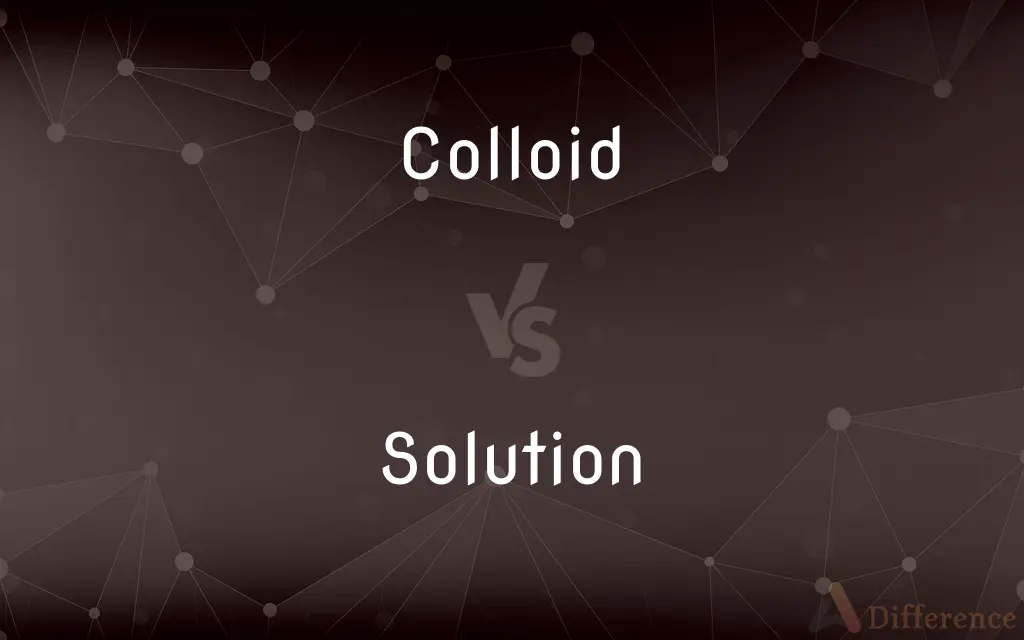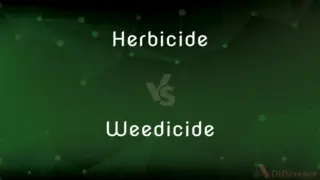Colloid vs. Solution — What's the Difference?
Edited by Tayyaba Rehman — By Fiza Rafique — Updated on September 25, 2023
A colloid is a mixture with medium-sized particles that don't settle out. A solution is a homogenous mixture with one substance dissolved in another. Colloids scatter light; solutions don’t.

Difference Between Colloid and Solution
Table of Contents
ADVERTISEMENT
Key Differences
Colloids and solutions are both mixtures, but their nature and behavior vary significantly. A colloid comprises medium-sized particles that are larger than those in a solution but smaller than those in a suspension. These particles are dispersed throughout a medium and, crucially, do not settle out or separate upon standing. For instance, in milk, a colloid, the fat droplets are dispersed throughout the liquid. Solutions, on the other hand, are homogenous mixtures with particles at the molecular or ionic level, making them much smaller than colloidal particles.
An interesting characteristic of colloids is the Tyndall effect. When light passes through a colloid, it gets scattered by its particles, causing the path of light to be visible. This phenomenon is absent in solutions. If you were to shine a light through fog, a colloid, you'd notice the light scattering, but this wouldn’t occur with a clear salt solution, a true solution, as it remains transparent.
Solutions possess uniform compositions, meaning that any sample taken from a solution will have the exact composition as any other sample from the same solution. In a sugar solution, for example, the sweetness is uniform throughout. In contrast, while colloids appear uniform to the naked eye, under a microscope, one can discern the dispersed particles.
Comparison Chart
Particle Size
Medium-sized (larger than solution).
Very small (molecular or ionic level).
Settling of Particles
Don't settle out.
Don't settle out.
ADVERTISEMENT
Transparency
Usually opaque or translucent.
Transparent.
Tyndall Effect
Present (scatters light).
Absent (doesn’t scatter light).
Uniformity
Appears uniform but not at microscopic.
Uniform at all levels.
Compare with Definitions
Colloid
A mixture displaying the Tyndall effect.
When shining light through butter, a colloid, it scatters due to the Tyndall effect.
Solution
A liquid containing dissolved particles at the molecular or ionic level.
A sugar solution is clear and transparent.
Colloid
A stable dispersion of particles in a medium.
Mayonnaise is a colloid of oil droplets in water.
Solution
A mixture where solute particles are completely dispersed in a solvent.
In a coffee solution, coffee solids are dispersed uniformly in water.
Colloid
A mixture with particles that are intermediate in size.
Whipped cream is a type of colloid with air dispersed in cream.
Solution
A consistent and uniform liquid phase with dissolved components.
The alcohol solution had a consistent concentration throughout.
Colloid
A heterogeneous mixture where particles don't settle out.
Fog is a colloid formed by water droplets in the air.
Solution
A method or process of dealing with a problem
Sought a solution to falling enrollments.
Colloid
A system with one substance microscopically dispersed throughout another.
Gelatin desserts are colloids with liquid dispersed in a solid.
Solution
The answer to a problem or the explanation for something
The solution to the mystery.
Colloid
A colloid is a mixture in which one substance of microscopically dispersed insoluble particles are suspended throughout another substance. However, some definitions specify that the particles must be dispersed in a liquid, and others extend the definition to include substances like aerosols and gels.
Solution
A homogeneous mixture of two or more substances, which may be solids, liquids, gases, or a combination of these.
Colloid
A system in which finely divided particles, which are approximately 1 to 1,000 millimicrons in size, are dispersed within a continuous medium in a manner that prevents them from being filtered easily or settled rapidly.
Solution
The process of forming such a mixture.
Colloid
The particulate matter so dispersed.
Solution
The state of being dissolved
Nitrogen that is in solution in the ocean.
Colloid
The gelatinous stored secretion of the thyroid gland, consisting mainly of thyroglobulin.
Solution
(Archaic) The act of separating or breaking up; dissolution.
Colloid
Gelatinous material resulting from degeneration in diseased tissue.
Solution
A homogeneous mixture, which may be liquid, gas or solid, formed by dissolving one or more substances.
Colloid
Of, relating to, containing, or having the nature of a colloid.
Solution
An act, plan or other means, used or proposed, to solve a problem.
Colloid
Glue-like; gelatinous.
Colloid tumours
Solution
An answer to a problem.
Colloid
(chemistry) A stable system of two phases, one of which is dispersed in the other in the form of very small droplets or particles.
Solution
(marketing) A product, service or suite thereof, especially software.
Colloid
(meteorology) An intimate mixture of two substances, one of which, called the dispersed phase (or colloid), is uniformly distributed in a finely divided state throughout the second substance, called the dispersion medium (or dispersing medium).
Solution
Satisfaction of a claim or debt.
Colloid
(geology) A particle less than 1 micron in diameter, following the Wentworth scale
Solution
The act of dissolving, especially of a solid by a fluid; dissolution.
Colloid
Resembling glue or jelly; characterized by a jellylike appearance; gelatinous; as, colloid tumors.
Solution
The crisis of a disease.
Colloid
A substance (as albumin, gum, gelatin, etc.) which is of a gelatinous rather than a crystalline nature, and which diffuses itself through animal membranes or vegetable parchment more slowly than crystalloids do; - opposed to crystalloid.
Solution
To treat with a solution.
Colloid
A gelatinous substance found in colloid degeneration and colloid cancer.
Solution
The act of separating the parts of any body, or the condition of undergoing a separation of parts; disruption; breach.
In all bodies there is an appetite of union and evitation of solution of continuity.
Colloid
A mixture with properties between those of a solution and fine suspension
Solution
The act of solving, or the state of being solved; the disentanglement of any intricate problem or difficult question; explanation; clearing up; - used especially in mathematics, either of the process of solving an equation or problem, or the result of the process.
Solution
The state of being dissolved or disintegrated; resolution; disintegration.
It is unquestionably an enterprise of more promise to assail the nations in their hour of faintness and solution, than at a time when magnificent and seductive systems of worship were at their height of energy and splendor.
Solution
The act or process by which a body (whether solid, liquid, or gaseous) is absorbed into a liquid, and, remaining or becoming fluid, is diffused throughout the solvent; also, the product resulting from such absorption.
Solution
Release; deliverance; discharge.
Solution
The termination of a disease; resolution.
Solution
A homogeneous mixture of two or more substances; frequently (but not necessarily) a liquid solution;
He used a solution of peroxide and water
Solution
A statement that solves a problem or explains how to solve the problem;
They were trying to find a peaceful solution
The answers were in the back of the book
He computed the result to four decimal places
Solution
A method for solving a problem;
The easy solution is to look it up in the handbook
Solution
The set of values that give a true statement when substituted into an equation
Solution
The successful action of solving a problem;
The solution took three hours
Solution
A homogenous mixture of two or more substances.
Saltwater is a solution of salt dissolved in water.
Solution
A combination that doesn’t display the Tyndall effect.
When light shines through a salt solution, it doesn’t scatter.
Common Curiosities
Why does milk appear cloudy?
Because it's a colloid with fat droplets dispersed in water.
What happens if I shine a light through a solution?
The solution remains transparent and doesn't scatter the light.
Is every clear liquid a solution?
Not necessarily; some clear liquids like gel can be colloids.
Can I separate a solution by letting it sit?
No, the components of a solution won’t separate on standing.
Why can’t I see through some colloids?
Due to the dispersed particles that make them opaque or translucent.
Can I see the particles in a colloid?
Usually not with the naked eye, but under a microscope, you can.
Is soda a solution or colloid?
Soda is primarily a solution with dissolved gases, but the bubbles can make it behave like a colloid.
What's the solvent in a sugar solution?
The solvent is the substance that does the dissolving, so it's water.
Why don’t particles settle in a colloid?
They’re small enough to be dispersed but too large to settle quickly.
What's the Tyndall effect in colloids?
It's the scattering of light as it passes through a colloid.
Can I easily separate the components of a solution?
Often, through methods like evaporation or distillation.
Is air a solution or colloid?
Air is primarily a solution of different gases.
What determines the state of a colloid?
The nature of both the dispersed phase and the dispersion medium.
How can I determine if a mixture is a colloid?
If it's heterogeneous at a microscopic level but doesn't separate on standing, it's likely a colloid.
Are the particles in a solution charged?
In ionic solutions, they are charged ions, but in molecular solutions, they're neutral molecules.
Share Your Discovery

Previous Comparison
Herbicide vs. Weedicide
Next Comparison
Graph vs. GraphicsAuthor Spotlight
Written by
Fiza RafiqueFiza Rafique is a skilled content writer at AskDifference.com, where she meticulously refines and enhances written pieces. Drawing from her vast editorial expertise, Fiza ensures clarity, accuracy, and precision in every article. Passionate about language, she continually seeks to elevate the quality of content for readers worldwide.
Edited by
Tayyaba RehmanTayyaba Rehman is a distinguished writer, currently serving as a primary contributor to askdifference.com. As a researcher in semantics and etymology, Tayyaba's passion for the complexity of languages and their distinctions has found a perfect home on the platform. Tayyaba delves into the intricacies of language, distinguishing between commonly confused words and phrases, thereby providing clarity for readers worldwide.
















































